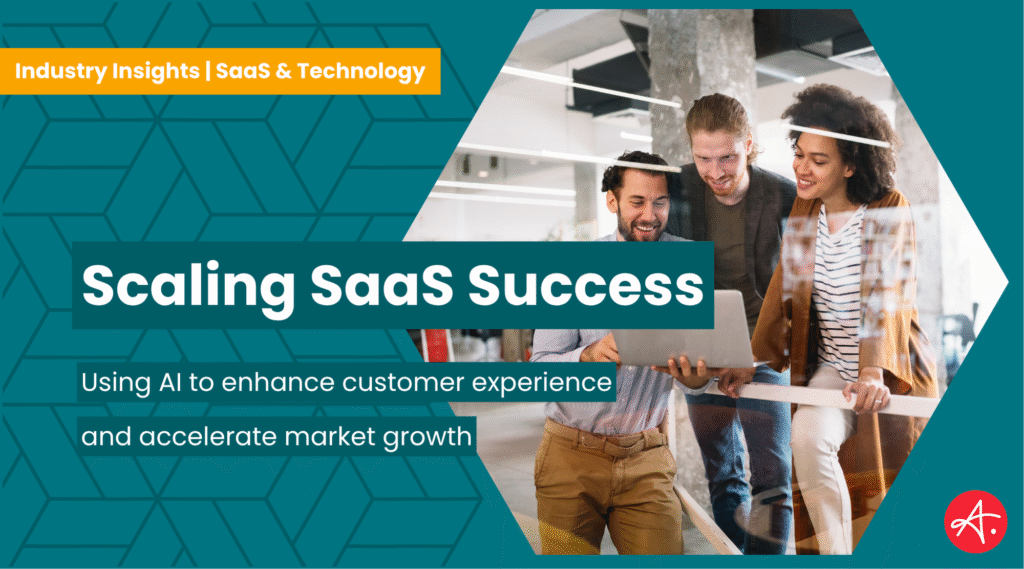Scaling SaaS Success: Using AI to Enhance Customer Experience and Accelerate Market Growth

Artificial intelligence isn’t just another technology trend, it’s fundamentally reshaping how SaaS companies build, deliver, and grow. From collapsing traditional development cycles into real-time iteration, to enabling hyper-personalized customer experiences at scale, AI is redefining the rules of competition.
In this virtual panel, we asked three Authentic CMOs — Peter Zaballos, Patrick Reiter, and Heather Battison — to share their perspectives on how AI is disrupting software development, transforming customer engagement, and forcing SaaS companies to rethink their go-to-market strategies.
How is AI disrupting traditional development cycles, and how should SaaS companies respond?
Peter: My sense is AI will follow the same adoption/disruption model prior generations of new technologies have followed. AI is transforming foundational aspects of many roles — starting with content creation and editing. SaaS companies need to embrace this change. If all employees in the organization are not actively exploring and making use of AI to improve the quality and productivity of their roles, then they will be at serious risk of becoming obsolete.
AI is transformative, but like with the introduction of the PC and the Internet, it will take years and years for this technology to reach maturity.
Patrick: The resources needed to develop software and related technology are changing quickly, the barriers that existed, even months ago, are now materially lower and we’re still in the early stages of this evolution. We hear a lot of how this impacts software engineers, but the ripple effect extends into product teams and other business teams as well. Historically, companies that maintain a focus on delivering value to their customers, while adopting new technology, remain healthy and receive a tailwind from the embrace of new technology. This should allow them to build, and in some cases buy, to remain competitive.
At this point it seems like pointing out the obvious, but AI must be embraced within the lens of providing customer value.
Heather: AI is changing the expectations of the people using it. Traditional development cycles used to move in quarters, but AI pushes everything into real-time. That means SaaS companies, or any technology development company for that matter, can’t afford to only think about product roadmaps and sprints—they also have to rethink how they listen, learn, and respond to customers.
And likewise, you have to redefine the role of marketing from traditional acquisition and retention functions to being stewards of real-time customer intelligence to ultimately provide a better experience. AI makes it possible to tailor experiences on the fly, and marketing teams are essential to make sure those experiences still feel human and authentic.
How can SaaS companies leverage AI not just to personalize, but to dynamically adapt products to individual users in real-time?
Patrick: This is a challenging question and especially so given where we are in the AI timeline, it may not seem like it, but it’s still early. The example that comes to mind is how platforms like ChatGPT adapt to conversations over time, which is personalization, but feels more significant as the outputs of the product and in the product itself is adapting based on history.
The applications here are myriad; we’re seeing agencies build products on AI platforms based on specific use cases and these are refined at the client level and we do this at Authentic. Many SaaS companies are building AI agents that do something similar. My sense is that this will change so much that it’s hard to even predict what this will look like in a year or two.
Heather: Because of the evolution of AI and overall human acceptance of it, for the most part, it no longer seems “creepy” that a product knows and understands you. Moving beyond traditional segmentation and more toward behavioral intelligence, AI systems that constantly learn from how users interact with features and can make the data applicable by enhancing as you go are the direction we’re heading in. Similar to how financial services companies currently use AI to proactively adjust product offerings, nudge savings behaviors, or flag risk profiles.
I see a major benefit in having the ability to continuously optimize user journeys. AI can serve up different product options or dashboards based on what the user needs at that moment, eliminating friction. It goes beyond the initial intuitive approach; it knows you and what you are looking for. Ultimately, dynamic AI-driven adaptation turns SaaS products from a static tool into a responsive partner.
Peter: AI enables dynamic personalization of experiences – across all media types. The more engagement history you can present an AI resource, the richer the experience. AI enables dramatic friction reduction in user experiences, and can speed the buyer’s journey by quickly identifying specific solutions based on greater insight into the prospect’s needs and priorities.
As important, AI also shortens the path between an action and a response. That can apply with as much relevance in an exchange of simple information (like contact info for a white paper), and a much more complex initiative, like creating multiple campaigns, utilizing multiple tactics with each touchpoint crafted for the specific needs and interests of each prospect.
AI, like the PC and Internet, enables dramatic efficiencies and capabilities holistically. And understandably, it will take multiple generations of applications, experiences, and insight to unlock AI’s full potential. So this is super important, and is a long game. It’s important to embrace AI now, and head down the experience curve as quickly and efficiently as you can.
In the era of AI-native software, how should companies rethink their market differentiation and go-to-market strategies?
Heather: Your GTM playbook must be as adaptive as the technology itself. You have to learn as you go more than ever before. Also, you can’t just rely on AI – with so much heightened awareness of it comes great skepticism on what is real versus a bot. This is the case especially for DTC companies. It is crucial while using AI, to also demystify how that intelligence is applied to be transparent and still include that human aspect.
Peter: I believe that companies need to embrace this, and internalize just how much speed, responsiveness, and personalization AI enables across organizations. This is a tectonic shift in computing, and entirely new methods, capabilities, and sources of value are opening. Along the way there will be excitement, confusion, concern. That’s not unique to AI, it’s the characteristic of a generational advancement of computing.
The genie is not going back in the bottle. Approach the AI future with a flexible, open mindset and buckle in for a wild, and profitable ride on this next wave of computing innovation.
Patrick: The how of go-to-market is being completely redefined. The way we work is shifting faster than most of us can process — AI now handles much of the knowledge work, from research and best-practice synthesis to building systems and automating workflows.
How we reach people is also changing. AI platforms are already replacing traditional search behaviors, and human–AI interactions will likely grow alongside human–human ones. This shift could reshape how we connect, communicate, and deliver content — with capabilities like instant video and ad creation already here and improving rapidly.
Measurement and analysis are evolving, too. As trust in AI systems grows, we’ll increasingly delegate analytics, forecasting, and other data-heavy tasks to intelligent agents. Barriers like time, expertise, and computing power are disappearing, enabling both simplicity and deep insight at once.
While the “how” is changing dramatically, the “what” — the brand, the product, and the behaviors we aim to influence — largely remains the same. Our goal is still to shape perceptions and drive action, whether that’s a purchase, a vote, or a download.
Interested in how an experienced CMO could help your organization achieve strategic growth using artificial intelligence? Reach out to us today.


